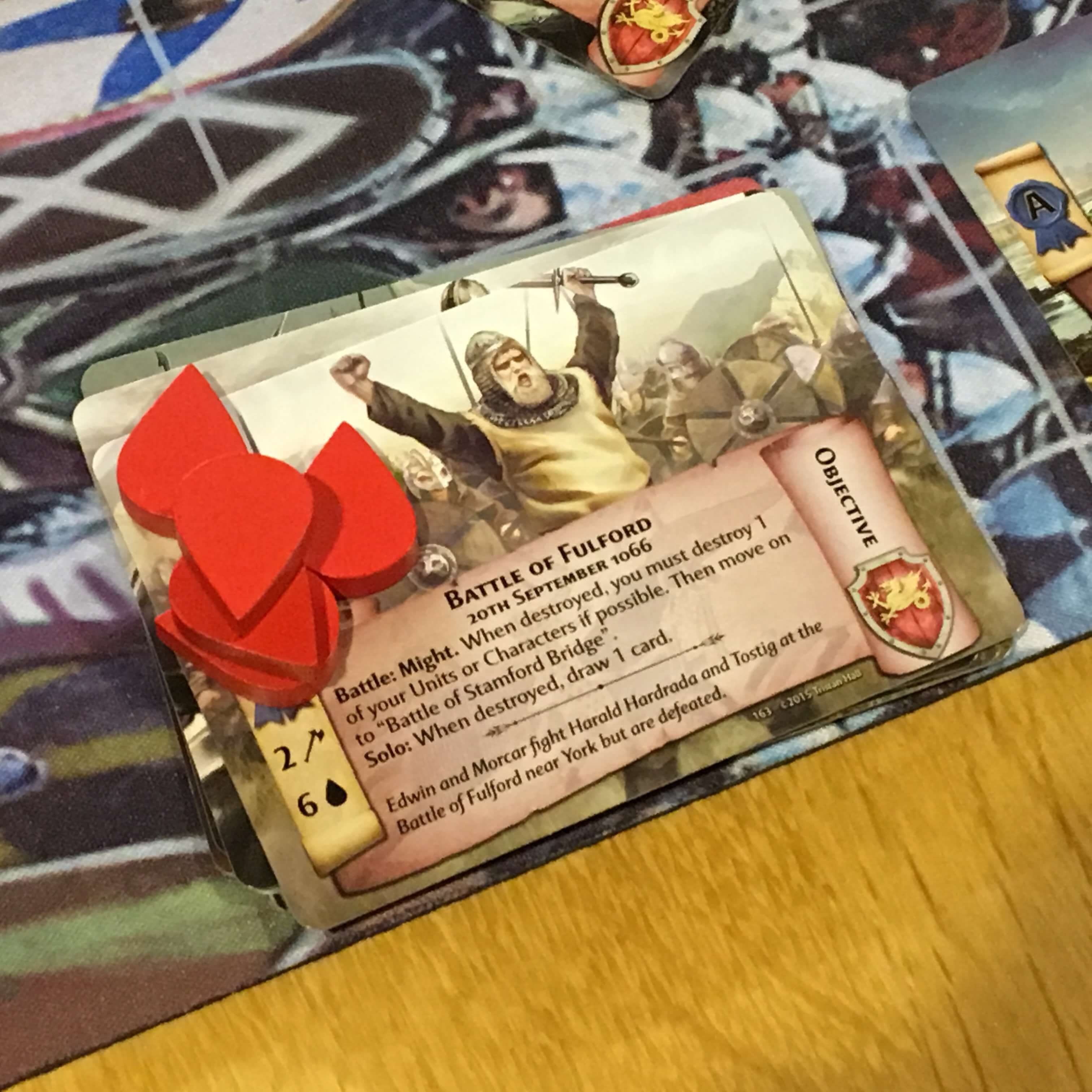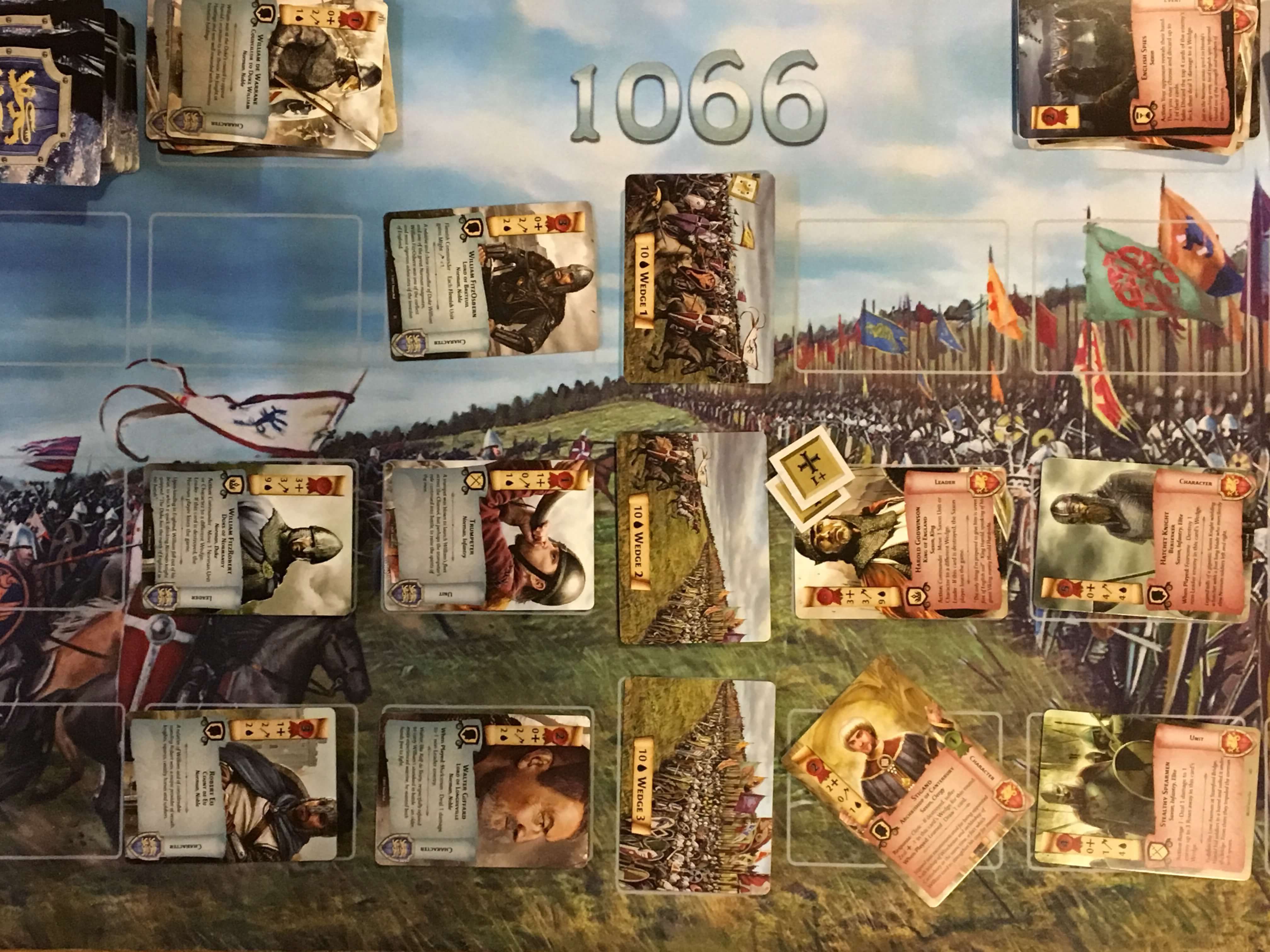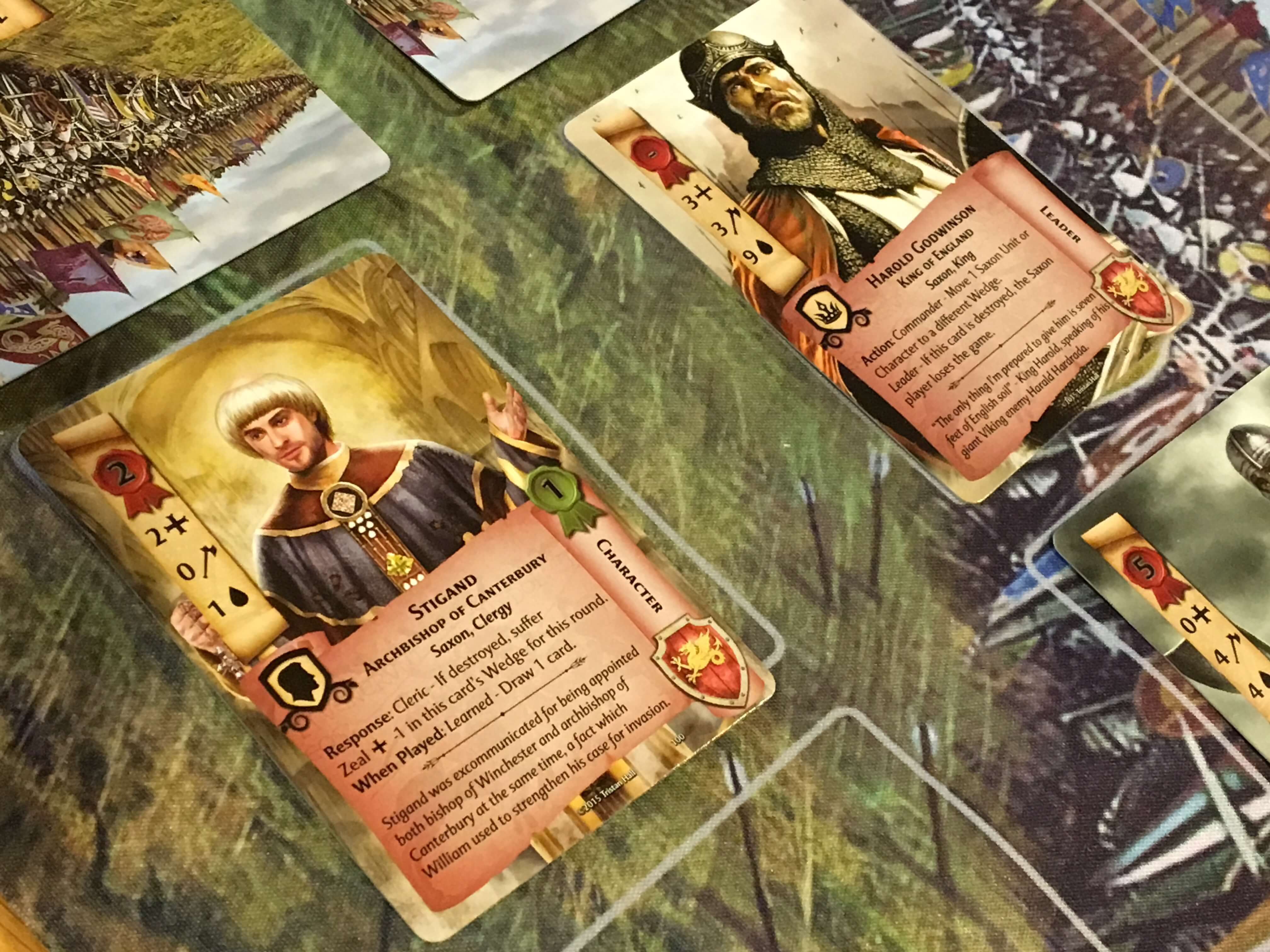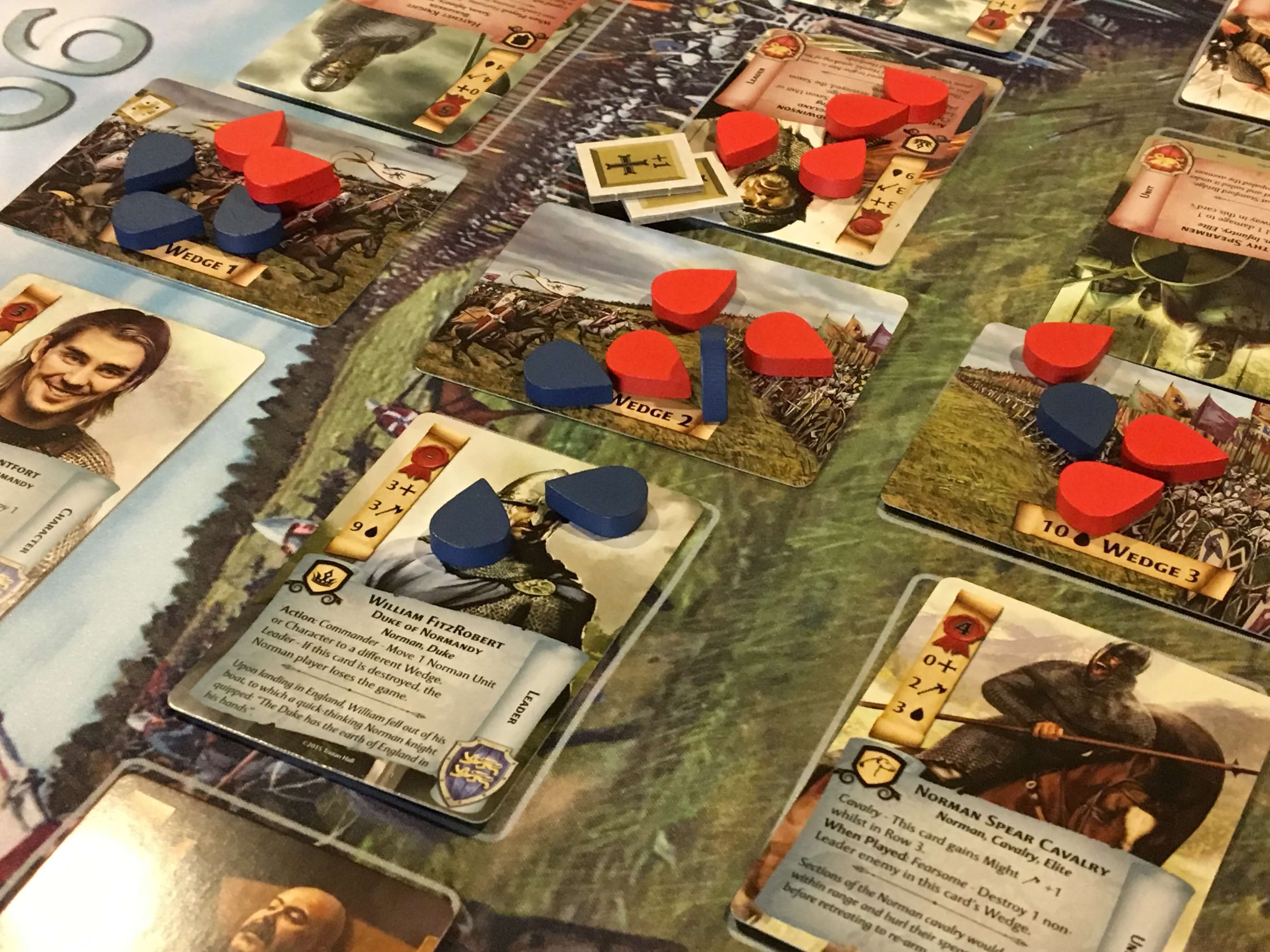1066, Tears to Many Mothers review — Mama, I just killed a man
![]()
- 1066, Tears to Many Mothers is the most recent release from Hall or Nothing, the design and publishing house ran by Tristan Hall. It shares the similar richly detailed artwork of Hall’s debut game, the hugely successful Gloom of Kilforth.
Obvious enough for history buffs, 1066 follows the events leading up to and during the pivotal Battle of Hastings, which — as most people know — set the course for England’s medieval future. 1066 is a one or two player card game that allows players to experience this tumultuous period of history, albeit over the course of around an hour of play.
Overview
1066 is a highly thematic game that takes not only the Battle of Hastings itself into account, but also the run up to it. There are perhaps three different ways to win, which involve focussing on either Zeal or Might and pressing your advantage on the battlefield, or by taking the fight directly to the enemy commander. Events leading up to the final battle are depicted as objectives cards, each of which will usually be defeated as a product of the strength of the players army.
Both William, the Norman invader, and Harold, King of England, are represented in person on their respective sides of the battlefield, but each of the seven objectives that they must complete are thematically different, even though overcoming them often boils down to the same thing. William, for example, must demonstrate the righteousness of his cause (a test of zeal) at the war council in Rouen. Harold, on the other hand, faces a number of military tests, such as The Battle of Stamford Bridge. Often, the players will both arrive at their final objective, The Battle of Hastings, on or around the same turn, but sometimes one of the players can fall behind.
This matters, because whilst attacking the enemy leader directly is perhaps the simplest way to win, it can be easier to build up a large military force and then win the final battle. This is done by placing cards on the battlefield in each of three wedges, which are themselves three rows deep (allowing for nine cards to be in play on each side at most.) Do enough damage to claim victory in two wedges and you’ll win the game — but this will realistically only be possible once The Battle of Hastings objective has been reached.
1066 uses a mixture of deck destruction and onboard resources to enable players to play units, characters and tactics onto the board, turn by turn. If you’d like to play a card, you simply need to discard a number of other cards equal to its value, or exhaust cards that generate resources (with a green rosette) by turning them sideways. As the game goes on, you’ll likely put more and more resource generating cards into play, which in turn will enable you to play more and more powerful cards. There’s no ambiguity in 1066; it’s a one on one game with clear victory conditions and a playtime that realistically can’t go beyond about an hour, thanks to the fact that once a deck of cards is exhausted that player loses the next time they come to draw.

Components
The artwork of 1066 is, from the very first glance, incredible. Each card is beautifully illustrated in a style that is a blend between photorealism and heavy oil painting. It’s a striking look and it really made me wonder how Hall or Nothing achieved it — was it using models dressed in period clothing, then enhanced digitally? Is the artwork hand-drawn? If it is, the standard achieved is almost unbelievable, but whatever the method, 1066 is likely to be a unique looking product in your collection (unless, of course, you own Gloom of Kilforth, which does use a similar style.
In the photographs you’ll see in this review, I’ve used the optional play mat, which certainly enhanced the experience for me. Whilst the card stock in 1066 is of a similar standard to most leading TCG’s (Magic: The Gathering etc) it’s still very challenging to play a game like this on a bare table — picking up and manipulating cards will lead to worn edges and marks that might even distinguish individual cards. If you are interested in purchasing the play mat, then I would say that its custom shape and printed card slots make it perfect for 1066’s layout. The mat is also of excellent quality, but the image of two clashing armies is perhaps of a slightly less impressive level of detail than the actual card art — perhaps because it’s printed on cloth.
There are two instruction manuals in 1066, which describe the standard two player game and the solo mode in turn. Both are large A4 booklets that present all pertinent detail to a reasonable standard. I think that 1066 is perhaps a simpler game than the manual presents, but even so, it can be learned in a single readthrough and some dummy turns. 1066 comes with little else in the box, but there is the nice addition of both blue and red teardrops which are used to represent health, as well as tokens to show increases in zeal or might.
As a final note, I’d say that 1066 comes in a box which is about twice as large as it needs to be – there’s a lot of empty space inside. I understand why; retail games need to fight harder than ever before to be seen, but I do think that there’s something to be said for being able to boast that you’ve created a deep and intriguing board game that comes in a box compact enough to travel with.

Turn structure
As I mentioned earlier, there are two stages to 1066, which literally amount to preparing for The Battle of Hastings and then fighting in it. Whichever phase of the game you’re in, you’ll perform the same actions each turn, it’s just that whether the battle is underway or not will change the win conditions and some of the available actions. Whilst it’s possible to win the game by killing your opponents leader before the battle begins, this isn’t often a viable strategy — the opposing decks are quite deep and direct damage cards are infrequent.
On a typical turn, the players will begin by moving any exhausted cards into the rested position (untapping them, to use popular language from other games of this sort) and then drawing either two or three cards. In the two card variant, players simply get to keep what they draw, but in the three card (and more interesting) variant, they add the three cards to any already in hand, but must then discard one from their newly combined hand.
The players then take turns to deploy cards onto the battlefield based on their cost. A cost of five can be paid in any combination of either the green rosette values shown on some cards on the battlefield (at which point those cards are exhausted and turned sideways) and by discarding cards. A five value card, for example, would need five other cards to be discarded, with one less for each point taken from a rosette. With a starting hand of six cards and two added each turn, there will only generally be one or two cards hitting the battlefield per round.
With their cards played, as long as neither player is at The Battle of Hastings objective, then they’ll test the strength of their armies against whatever the current objective for their side is. For the English, these objectives mostly test Harold’s might, whilst for William, they test zeal. Each player counts up their total might or zeal and then compares it to the value on the objective, the difference in teardrops is then added to the objective card. When teardrops exceed the objective health, the objective is complete and an action (such as drawing a card or destroying a unit) is executed. Broadly speaking (aside from bits of cleanup) the turn cycle begins again.
The key difference once a player (or both players) reach The Battle of Hastings objective is the introduction of the wedges. There are three of these, each representing one of William’s so-called battles (or formations, in practical terms) and providing the key win conditions for 1066. Whether zeal or might is used, at this point, the objective becomes focussed on being the first to score ten points of damage to two of the wedges by overpowering the opposing force. The first to do so, wins.

Game experience
Although 1066 is a simple game to learn and play, there’s quite a lot going on. Firstly, the decks are highly asymmetric and also quite deep. This has the dual effect of making it possible to play several games of 1066 and not use (or even see) every card in both decks, as well as to ensure that it’s simply impossible to assume that any specific strategy can be repeated from one game to the next.
I mentioned earlier that I doubt a “kill The King” strategy is viable, but if you draw all the right cards in a row then in that particular game, it will be. There are lots of occasions in 1066 where you’ll be asked to draw an extra card, but as this is a balanced game with fixed decks, there are no cards that allow broken shenanigans — you’ll never be allowed to search the deck for your favourite card, for example. Luck of the draw is definitely a factor, but to be unlucky over the course of the entire game is very, very unlikely.
In any case, you’ll probably forgive 1066 for this, since luck and to a certain extent confusion feel very thematically relevant given the subject matter. It’s also hard to complain about the effect of luck in a card game that is usually over in about thirty minutes and certainly over in less than an hour. In almost every game I played, both sides reached the final objective on the same turn, or at worst no more than two turns apart. The fact that William largely chases zeal in order to progress whilst Harold looks for might is a subtle way to balance the game — since each should have a distinct way to do damage going into the wedge battles.
In solo mode, 1066 also flows remarkably well thanks to a smart way of increasing the resources aligned to what the game calls “The Foe.” The Foe follows a simple rule that allows them to deploy more and more powerful forces on each turn, with clear rules for how to handle placement of cards on the battlefield, as well as the behaviour for cards with ranged attacks (for example) which can target the enemy leader — especially Harold. There are three difficulty levels to choose from and whilst I’d say that they are slightly easier than I was expecting, the hard mode did beat me once, but then I beat it on the next attempt.

Conclusion
Although, much like the Norman army when rumours of William’s death spread among them, I did waver about placing 1066 on my long term keep shelf. That happened only because of the fact that I think I’ll struggle to play it regularly, but I held my nerve and added it anyway. 1066 offers a completely unique experience that I don’t think you can find anywhere else. The historic theme, the simplicity of play, the fact that 1066 exists in a vacuum that is very unlikely to be expanded upon piecemeal by unwelcome expansions (although I understand that future standalone products from Hall or Nothing might make intergame battles possible). These things all make 1066 a really exciting game.
I’ve described it in this way to a number of my friends and most have them have been instantly excited to play it, but those who weren’t immediately changed their minds once they saw the exceptional components. 1066 is a game that features artwork that drips with theme and really enhances the overall experience, underpinning the already excellent link between mechanics and historical interest. Overall I think 1066 is an excellent game that is perhaps only slightly marred by high levels of chance and the fact that head to head (or solo) play won’t be for everyone. 1066 comes highly recommended, especially if you have an interest in history, or a desire to share your interest with others — teenage children, for example.
A copy of 1066, Tears to Many Mothers was provided for review purposes. You can find out more about it on the website of publisher Hall or Nothing.

Comments are closed.